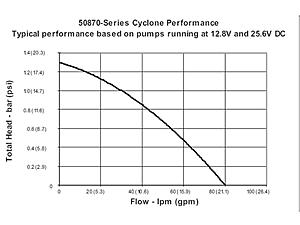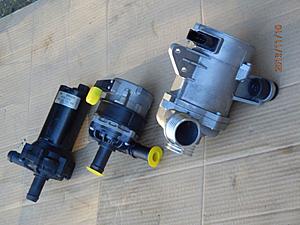Understanding Intercooling, Charge-Coolers, Heat Exchangers and Circulation Pumps
#102
MBWorld Fanatic!
Thread Starter
It was a while ago now, but like Lingenfelter and Nunnalley I spent a lot of time measuring pump performance. But it wasn't very productive. My intention was to test all configurations of pump and heat exchanger, working as a system.
Firstly I baselined the stock pump & HE, so see where I was starting from. Then I substituted the Pierburg pump, and tested that with the stock HE, to see how much improvement I could get from the big pump in isolation. Then I hooked-up the BMW radiator, and finally went back to the Bosch pump, specifically to see whether the stock HE was restricting flow. Knowing that the Pierburg was an engine pump, I suspected that the full benefit might only come when used in a low-restriction system, but I wanted to see for sure.
Rather than using a bucket and stopwatch, or a fancy ultrasonic flowmeter, I plumbed-in a simple 3/4" impeller water meter to the HE outlet, and measured the flow round the closed-circuit. Of course, for each configuration I tested, I had to drain, fill and bleed the system each time. Have you ever heard people say how difficult it is to bleed the V12TT system? Well its true, its an absolute nightmare. The water-antifreeze mix froths badly, and if you try to circulate it using the, it turns the whole system into a milkshake, and the flow gridlocks. In hindsight, I would have done the testing with plain water, but its too late now. I spent several whole days doing this, and really made very little useful progress.
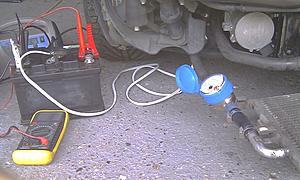
The engine wasn't ready to be run, so I used a battery charged up to about 13.0V. Even that lost some voltage during the testing, and the flow figures suffered, so I hooked-up an 8A charger during the testing to keep the voltage up. The test above is the stock HE feeding into the water meter, and then into the stock pump, in front of the wheel.
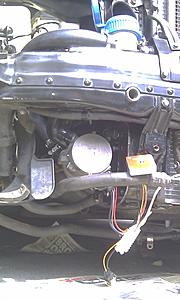
Above, here's the X3 radiator outlet feeding the meter with appropriate pipes. The Pierburg pump is controlled by the tiny Tecomotive pump controller. Both the Bosch and Pierburg pumps ran pretty quietly, and apart from the meter, it was quite easy to avoid leaks - hardly even any need for the jubilee clips.
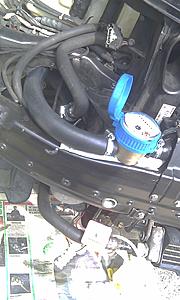
I eventually rationalized the whole test into two tests - all stock and all modified. I wasn't even able to do the first until I'd developed a completely new way to fill and bleed the system. You just can't can't get any meaningful results until all the air is out of the system.
And rather like the Lingfelter and Nunnalley tests, the stock results weren't as good as you might have expected. The best I could do was about 14 litres/min, or 3.7 US gpm.
With the BMW pump and radiator, I got about 50% more flow: 21 lpm/5.5 gpm. I was disappointed with that, but in hindsight its a good result.
It shows that an IC system really does need an IC pump, and not an engine cooling pump. The Pierburg CWA-100 would probably be more suitable than the CWA-200, but the VariMax sounds like a good option. On this occasion, I'll just have to live without knowing how restrictive the stock HE is, and how much more flow I got just by fitting the X3 rad.
Nick
Firstly I baselined the stock pump & HE, so see where I was starting from. Then I substituted the Pierburg pump, and tested that with the stock HE, to see how much improvement I could get from the big pump in isolation. Then I hooked-up the BMW radiator, and finally went back to the Bosch pump, specifically to see whether the stock HE was restricting flow. Knowing that the Pierburg was an engine pump, I suspected that the full benefit might only come when used in a low-restriction system, but I wanted to see for sure.
Rather than using a bucket and stopwatch, or a fancy ultrasonic flowmeter, I plumbed-in a simple 3/4" impeller water meter to the HE outlet, and measured the flow round the closed-circuit. Of course, for each configuration I tested, I had to drain, fill and bleed the system each time. Have you ever heard people say how difficult it is to bleed the V12TT system? Well its true, its an absolute nightmare. The water-antifreeze mix froths badly, and if you try to circulate it using the, it turns the whole system into a milkshake, and the flow gridlocks. In hindsight, I would have done the testing with plain water, but its too late now. I spent several whole days doing this, and really made very little useful progress.

The engine wasn't ready to be run, so I used a battery charged up to about 13.0V. Even that lost some voltage during the testing, and the flow figures suffered, so I hooked-up an 8A charger during the testing to keep the voltage up. The test above is the stock HE feeding into the water meter, and then into the stock pump, in front of the wheel.

Above, here's the X3 radiator outlet feeding the meter with appropriate pipes. The Pierburg pump is controlled by the tiny Tecomotive pump controller. Both the Bosch and Pierburg pumps ran pretty quietly, and apart from the meter, it was quite easy to avoid leaks - hardly even any need for the jubilee clips.

I eventually rationalized the whole test into two tests - all stock and all modified. I wasn't even able to do the first until I'd developed a completely new way to fill and bleed the system. You just can't can't get any meaningful results until all the air is out of the system.
And rather like the Lingfelter and Nunnalley tests, the stock results weren't as good as you might have expected. The best I could do was about 14 litres/min, or 3.7 US gpm.
With the BMW pump and radiator, I got about 50% more flow: 21 lpm/5.5 gpm. I was disappointed with that, but in hindsight its a good result.
It shows that an IC system really does need an IC pump, and not an engine cooling pump. The Pierburg CWA-100 would probably be more suitable than the CWA-200, but the VariMax sounds like a good option. On this occasion, I'll just have to live without knowing how restrictive the stock HE is, and how much more flow I got just by fitting the X3 rad.
Nick
Last edited by Welwynnick; 01-17-2014 at 10:45 AM.
#104
MBWorld Fanatic!
Thread Starter
Looking at the Lingenfelter and CaddyInfo threads on Mercedes, Cadillac & Chevy, I think there's a very clear conclusion to be had, and a new direction to look for suitable IC pumps.
IC systems are quite unlike engine cooling systems (or buckets of water for that matter). They're all HIGH RESISTANCE systems, so they need a lot of pressure to achieve good flow. Many pumps are rated for open flow, with no load, but that's almost totally useless for chosing an IC pump. If you want to use a single figure, the static pressure (maximum head) gives a better indication of improved performance, but pumps are more complicated than that, and you really need proper flow vs pressure curves, which is where the Lingenfelter tests are so useful.
There's a lot of talk about 20 gpm pumps, but 3-4 gpm is quite normal in the real world, and 5 gpm is a good figure. Its actually quite difficult to get even that high - I spent several days trying - and a high antifreeze concentration, an uncharged battery, or a tiny bit of air in the system, really knocks it back.
What this means is that pumps that are suitable for engine coolling, or that do well with the bucket test, aren't really suitable for IC systems. So that includes pretty much all Johnson, Meziere & Davies-Craig pumps. So that means that all the forum favourites, like the EWP-80, WP136, CM30 or even CM90, are no improvement on the Bosch. Many people swear by the Jabsco 50840, but even that's a high-flow/low pressure pump. In my searches, I found a couple of other likely 20gpm+ candidates - the Dayton 5PXX0 and the SURflow COMSV012D but they give much the same performance as the above:
http://www.drillspot.com/products/1380036/Dayton_5PXX0_Pump
http://www.pumpvendor.com/media/shurflo_industrial/Shurflo_Industrial_COMB_COMS_DC_series.pdf
IC systems normally run at around 0.5 bar, and if you want more flow, you need a lot more pressure. So you need to look for pumps that do 1 bar or more, and I found a couple of real candidates. They have 15-20 gpm open flow, but they achieve up to 1.1-1.2 bar, and the installed performance will be better than ALL the above.
The first is an identical twin big brother to the Jabsco 50840, called the 50860. It looks and cost about the same, has less open flow, but much more power, pressure and installed flow.
The other I never heard of before, but is rather expensive - the FLOJET DC 40/10.
http://www.xylemflowcontrol.com/marine-and-rv/general-purpose-pumps/circulation-pumps/50840-series-low-pressure-cyclone-centrifugal-pump-copy-item14187.htm
http://www.xylemflowcontrol.com/files/50860_43000-0858.pdf
http://www.aquaintl.com/product_details.php?category_id=786&item_id=3339
http://www.xylemflowcontrol.com/files/DC15_30_40_SS_950-0676.pdf
They're both monster pumps, bigger even than the Renntech pump, and I would guess similar to the stock Stewart-EMP E2512A that Lingenfelter promote so effectively in the top thread.
Nick
IC systems are quite unlike engine cooling systems (or buckets of water for that matter). They're all HIGH RESISTANCE systems, so they need a lot of pressure to achieve good flow. Many pumps are rated for open flow, with no load, but that's almost totally useless for chosing an IC pump. If you want to use a single figure, the static pressure (maximum head) gives a better indication of improved performance, but pumps are more complicated than that, and you really need proper flow vs pressure curves, which is where the Lingenfelter tests are so useful.
There's a lot of talk about 20 gpm pumps, but 3-4 gpm is quite normal in the real world, and 5 gpm is a good figure. Its actually quite difficult to get even that high - I spent several days trying - and a high antifreeze concentration, an uncharged battery, or a tiny bit of air in the system, really knocks it back.
What this means is that pumps that are suitable for engine coolling, or that do well with the bucket test, aren't really suitable for IC systems. So that includes pretty much all Johnson, Meziere & Davies-Craig pumps. So that means that all the forum favourites, like the EWP-80, WP136, CM30 or even CM90, are no improvement on the Bosch. Many people swear by the Jabsco 50840, but even that's a high-flow/low pressure pump. In my searches, I found a couple of other likely 20gpm+ candidates - the Dayton 5PXX0 and the SURflow COMSV012D but they give much the same performance as the above:
http://www.drillspot.com/products/1380036/Dayton_5PXX0_Pump
http://www.pumpvendor.com/media/shurflo_industrial/Shurflo_Industrial_COMB_COMS_DC_series.pdf
IC systems normally run at around 0.5 bar, and if you want more flow, you need a lot more pressure. So you need to look for pumps that do 1 bar or more, and I found a couple of real candidates. They have 15-20 gpm open flow, but they achieve up to 1.1-1.2 bar, and the installed performance will be better than ALL the above.
The first is an identical twin big brother to the Jabsco 50840, called the 50860. It looks and cost about the same, has less open flow, but much more power, pressure and installed flow.
The other I never heard of before, but is rather expensive - the FLOJET DC 40/10.
http://www.xylemflowcontrol.com/marine-and-rv/general-purpose-pumps/circulation-pumps/50840-series-low-pressure-cyclone-centrifugal-pump-copy-item14187.htm
http://www.xylemflowcontrol.com/files/50860_43000-0858.pdf
http://www.aquaintl.com/product_details.php?category_id=786&item_id=3339
http://www.xylemflowcontrol.com/files/DC15_30_40_SS_950-0676.pdf
They're both monster pumps, bigger even than the Renntech pump, and I would guess similar to the stock Stewart-EMP E2512A that Lingenfelter promote so effectively in the top thread.
Nick
Last edited by Welwynnick; 09-23-2013 at 08:36 AM.
#105
MBWorld Fanatic!
Thread Starter
Just a quick thought. I'm probably worrying about nothing (and it won't affect some people at all) but one of the quick wins for charge cooling is to have the IC pump running continuously.
But what happens in freezing weather? The coolant will circulate while the ignition is turned on, and after a cold start will presumably cool the IC to below zero.
Isn't there a risk of the IC freezing up?
Nick
But what happens in freezing weather? The coolant will circulate while the ignition is turned on, and after a cold start will presumably cool the IC to below zero.
Isn't there a risk of the IC freezing up?
Nick
Last edited by Welwynnick; 09-23-2013 at 08:39 AM.
#106
Senior Member
The flowjet pump is very interesting. I am doing a little more digging for specs. The Jabsco pumps are all only rated for thirty minutes on and thirty minutes off for only a 50% duty cycle. For a continuously running set up you might see a very early failure. They list a warning that the Jabsco pumps will get very hot. Any guess the rating on the pressure cap on the intercoolers system?
As for cold weather operation, as long as your antifreeze percentage is high enough to keep ice from forming you are in good shape. With the intercoolers sitting in the engine bay they will warm the system quickly. At best our IATs are 20 degrees above OAT. If you are using water wetter or another lubricant they will not protect against freezing.
I believe the Pierberg 100 Series pump is flow rated at .80 bar which is right in line with our operating range.
As for cold weather operation, as long as your antifreeze percentage is high enough to keep ice from forming you are in good shape. With the intercoolers sitting in the engine bay they will warm the system quickly. At best our IATs are 20 degrees above OAT. If you are using water wetter or another lubricant they will not protect against freezing.
I believe the Pierberg 100 Series pump is flow rated at .80 bar which is right in line with our operating range.
#107
MBWorld Fanatic!
Thread Starter
I think once the engine is running the turbos will warm the intake air enough to avoid freezing, but I was thinking of the scenario where the ignition is turned on some time before the engine is started. The IC will be freezing cold, and the intake air will be cold for a short while before the turbos warm up. The fins are close together, and I don't think it would be difficult for ice to block the whole intake, and then the engine wouldn't stand a chance of running. Anyone would be at a loss to diagnose that problem, which would mysteriously disappear.
On the upside, freezing cold air is dry, because the moisture has condensed and frozen out of it, so the problem might not be that bad. However, throttle bodies are often heated by engine water to avoid freezing. I admit that throttle bodies are a different case, as the air cools when it expands suddenly when passing a part-closed throttle, so you can get freezing of moisture-laden air. IC's are rather different, but this is mostly just me trying to cover things that might go wrong.
Yes, the Jabsco 50860 is rated for intermittent operation, and I think the FLOJET 40/10 is as well. However, the low pressure 50840 is continuously rated, as is the 24V version of the 50860, for some reason. As long as those big pumps are run under normal IAT thermostatic control, I think they'd be OK.
What we need for IC pumping is away from the mainstream for pump manufcturers, falling between the low pressure centrifugal pumps, and the high pressure diaphram pumps. Something like 1bar @ 30lpm will do, and the Pierburg CWA-100 is very close (and can be run from a Tecomotive controller, AND the motor is water-cooled). I was looking for another high flow/high pressure pump that's continuously rated, and I did come up with this promising option today - the Stuart Turner 12/50 series:
http://www.stuart-turner.co.uk/produ...250-/1250-12-v
http://www.stuart-turner.co.uk/media..._Datasheet.pdf
http://www.stuart-turner.co.uk/media...%20Section.pdf
http://www.stuart-turner.co.uk/media...ow-Voltage.pdf
http://www.stuart-turner.co.uk/media...ance-12-50.pdf
Of course the other option is to use two Bosch pumps - leave the stock one in situ and simply add another one at the HE inlet.
Nick
On the upside, freezing cold air is dry, because the moisture has condensed and frozen out of it, so the problem might not be that bad. However, throttle bodies are often heated by engine water to avoid freezing. I admit that throttle bodies are a different case, as the air cools when it expands suddenly when passing a part-closed throttle, so you can get freezing of moisture-laden air. IC's are rather different, but this is mostly just me trying to cover things that might go wrong.
Yes, the Jabsco 50860 is rated for intermittent operation, and I think the FLOJET 40/10 is as well. However, the low pressure 50840 is continuously rated, as is the 24V version of the 50860, for some reason. As long as those big pumps are run under normal IAT thermostatic control, I think they'd be OK.
What we need for IC pumping is away from the mainstream for pump manufcturers, falling between the low pressure centrifugal pumps, and the high pressure diaphram pumps. Something like 1bar @ 30lpm will do, and the Pierburg CWA-100 is very close (and can be run from a Tecomotive controller, AND the motor is water-cooled). I was looking for another high flow/high pressure pump that's continuously rated, and I did come up with this promising option today - the Stuart Turner 12/50 series:
http://www.stuart-turner.co.uk/produ...250-/1250-12-v
http://www.stuart-turner.co.uk/media..._Datasheet.pdf
http://www.stuart-turner.co.uk/media...%20Section.pdf
http://www.stuart-turner.co.uk/media...ow-Voltage.pdf
http://www.stuart-turner.co.uk/media...ance-12-50.pdf
Of course the other option is to use two Bosch pumps - leave the stock one in situ and simply add another one at the HE inlet.
Nick
Last edited by Welwynnick; 09-24-2013 at 04:30 PM.
#108
MBWorld Fanatic!
Thread Starter
Interesting article on Pierburg Electric Water Pumps here:
http://www.omiq.it/resources/Documen..._64_5_6_LR.pdf
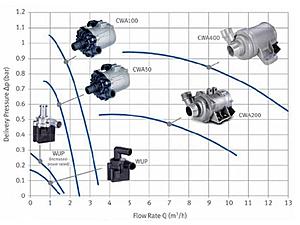
http://www.omiq.it/resources/Documen..._64_5_6_LR.pdf

Last edited by Welwynnick; 09-27-2013 at 12:26 PM.
#109
MBWorld Fanatic!
Thread Starter
#110
Ok so ive read the whole thread and still have a few questions. Before reading this thread I was gonna just upgrade the factory HE with a larger universal one of some sort along with a pump upgrade, like people have done in the past. But the pumps used don't seem to be like a good choice anymore.
First question is if I was to go the radiator route with a cap and overflow nipple does the nipple have to be sealed shut? does the cap need a certain psi rating? along with that (and this may be a stupid question) but if the all aluminum radiator had the oil cooler option could you route your ac lines to run through there to have like a slight killer chiller effect? not sure how the oil cooler portion of radiators are routed....
Second, is that it seems that the OP has proven that the pumps we usually upgrade to are no better than the factory so do we install a second factory (same specs) to run with the other inline? wired to kick on together
Or do we install a second one -<>- split to where one could run all the time and not affect the other and then the factory kick on as normal?
My plans are to upgrade these The HE and the IC Pump once I figure the best setup for me. Then add a snow performance boost activated meth injection kit solely for AIT's I wont be tuning for the injection just for the temps.
sorry for grammar, punctuation etc....lol its late and I don't care.
First question is if I was to go the radiator route with a cap and overflow nipple does the nipple have to be sealed shut? does the cap need a certain psi rating? along with that (and this may be a stupid question) but if the all aluminum radiator had the oil cooler option could you route your ac lines to run through there to have like a slight killer chiller effect? not sure how the oil cooler portion of radiators are routed....
Second, is that it seems that the OP has proven that the pumps we usually upgrade to are no better than the factory so do we install a second factory (same specs) to run with the other inline? wired to kick on together
Or do we install a second one -<>- split to where one could run all the time and not affect the other and then the factory kick on as normal?
My plans are to upgrade these The HE and the IC Pump once I figure the best setup for me. Then add a snow performance boost activated meth injection kit solely for AIT's I wont be tuning for the injection just for the temps.
sorry for grammar, punctuation etc....lol its late and I don't care.
#111
MBWorld Fanatic!
Thread Starter
If you go for a radiator, the whole system still has to be sealed, but not for quite the same reasons as the engine system (which needs a high boiling point - the IC doesn't). Rad & header caps are usually set about 1 bar, which should be fine.
I guess you could try running AC refrigerant through the oil cooler, but I think the latter isn't designed for high pressure, so there'd be a risk of rupture. Even the low side of an AC system has a few bar.
You're right, most of the popular "upgrade" pumps are clearly unsuitable for IC systems, but adding a second stock pump with the first is a good idea, especiallly if you wire it to the ignition. Its got to be in series with the existing pump though, so the pressures add, not the flows. I'd suggest fitting it in the front left-hand corner, near the HE inlet, but remember the pump outlet must always face upwards, to avoid air-locks.
Nick
I guess you could try running AC refrigerant through the oil cooler, but I think the latter isn't designed for high pressure, so there'd be a risk of rupture. Even the low side of an AC system has a few bar.
You're right, most of the popular "upgrade" pumps are clearly unsuitable for IC systems, but adding a second stock pump with the first is a good idea, especiallly if you wire it to the ignition. Its got to be in series with the existing pump though, so the pressures add, not the flows. I'd suggest fitting it in the front left-hand corner, near the HE inlet, but remember the pump outlet must always face upwards, to avoid air-locks.
Nick
#112
MBWorld Fanatic!
Thread Starter
I've been learning a bit more about centrifugal pumps, how to match them to the system, and how to upgrade them. There are some great resources out there, and some common-sense discussion of what happens when you double-up pumps for more flow:
http://www.engineeringtoolbox.com/pu...ial-d_636.html
http://www.mcnallyinstitute.com/15-html/15-01.htm
http://www.pumpindustry.com.au/under...parallel/2138/
http://wycopump.com/pdfs/pumpclinic35.pdf
Basically you can double pumps either in series or in parallel, and both techniques will increase system flow. One will be more successful than the other, though, and it depends on the characteristics of the pump and the system - which is flat and which is steep.
The simple effect of multiple pumps is:
Pumps in series add the pressure at the same flow rate
Pumps in parallel double the flow at the same pressure
There's a recurring theme across all those websites, and that's how important it is to match the pump to the system. Each pump has a preferred operating point on its pressure/flow curve. Its the condition that its designed (or tuned) to operate at, and its where you get the maximum efficiency and the hydraulic power. Hydraulic power is the product of pressure and flow. If you multiply litres / sec by kPa you get Watts (and in practice its almost always less than half the electrical input power).
The actual operating condition of a pump is where the pump curve (which slopes down) crosses the system curve (which slopes upwards). Both curves are shallow at low rates of flow, and get steeper at high flows. If the pump isn't matched to the system, it will operate away from its optimum operating range, and you won't get the best from it.
More than that though, it will also cause the pump to break down. If a pump has too little resistance (shallow system curve), it will over-speed and may cavitate, eroding the impeller. If the resistance is too high (steep system curve), all sorts of things go wrong. The flow and pressure around the impeller will not be uniform, and will be subject to noise, vibration, radial load and axial load. All of which will wear out the seals and bearings, and may cause the pump to overheat.
That's effectively what happens when you take a high-flow engine cooling pump and fit it into a typical high-resistance charge-cooling system. You get low flow and an unreliable pump. There's a lot of good science to this, and it all makes perfect sense.
Nick
http://www.engineeringtoolbox.com/pu...ial-d_636.html
http://www.mcnallyinstitute.com/15-html/15-01.htm
http://www.pumpindustry.com.au/under...parallel/2138/
http://wycopump.com/pdfs/pumpclinic35.pdf
Basically you can double pumps either in series or in parallel, and both techniques will increase system flow. One will be more successful than the other, though, and it depends on the characteristics of the pump and the system - which is flat and which is steep.
The simple effect of multiple pumps is:
Pumps in series add the pressure at the same flow rate
Pumps in parallel double the flow at the same pressure
There's a recurring theme across all those websites, and that's how important it is to match the pump to the system. Each pump has a preferred operating point on its pressure/flow curve. Its the condition that its designed (or tuned) to operate at, and its where you get the maximum efficiency and the hydraulic power. Hydraulic power is the product of pressure and flow. If you multiply litres / sec by kPa you get Watts (and in practice its almost always less than half the electrical input power).
The actual operating condition of a pump is where the pump curve (which slopes down) crosses the system curve (which slopes upwards). Both curves are shallow at low rates of flow, and get steeper at high flows. If the pump isn't matched to the system, it will operate away from its optimum operating range, and you won't get the best from it.
More than that though, it will also cause the pump to break down. If a pump has too little resistance (shallow system curve), it will over-speed and may cavitate, eroding the impeller. If the resistance is too high (steep system curve), all sorts of things go wrong. The flow and pressure around the impeller will not be uniform, and will be subject to noise, vibration, radial load and axial load. All of which will wear out the seals and bearings, and may cause the pump to overheat.
That's effectively what happens when you take a high-flow engine cooling pump and fit it into a typical high-resistance charge-cooling system. You get low flow and an unreliable pump. There's a lot of good science to this, and it all makes perfect sense.
Nick
Last edited by Welwynnick; 01-19-2014 at 09:14 AM.
#113
MBWorld Fanatic!
Thread Starter
Modern turbo-charged engines will typically have a 30mm thick intercooler and 30mm radiator, with a 16mm condenser sandwiched in between, and they will all have much the same width and height.
I've been doing a bit more research, and I have to correct myself there.
Recent cars that were designed around turbo engines almost invariably have the condensor at the front, and the intercooler sandwiched in between. I guess the condenser doesn't like the heat from the intake cooler.
Counter-flow heat exchangers (which are most efficient) are arranged hot-to-hot and cold-to-cold, so if the rad runs hotter than the HE runs hotter than the AC, then that's the logical sequence. It seems to have become the rule these days...
Recent cars that were designed around turbo engines almost invariably have the condensor at the front, and the intercooler sandwiched in between. I guess the condenser doesn't like the heat from the intake cooler.
Counter-flow heat exchangers (which are most efficient) are arranged hot-to-hot and cold-to-cold, so if the rad runs hotter than the HE runs hotter than the AC, then that's the logical sequence. It seems to have become the rule these days...
The S65 has a full-size HE in front of the condenser, but that's the exception to the rule.
Incidentally, this means that the S65 and CL65 use a different AC condenser to all the other models.
It opens an interesting option, though. My condenser has a steering cooler in the top, and I'm not planning to replace that. The S65 heat exchanger ALSO has a steering cooler at the top, which then becomes redundant. Can I think of anything to do with it? I certainly can! How about using it to cool the suspension oil, instead of that horrible little square cooler?
I like that idea.
Nick
#115
MBWorld Fanatic!
Thread Starter
http://www.hehlhans.de/motorg55-7.htm
Info: there's an illustrated procedure here to strip down the 0392022003 pump. It uses a conventional DC motor with brushes, so it will never last for very long. I think that must explain why the motor doesn't run all the time. The Pierburg pump uses an electronic commutator, so it has no brushes, and is presumably more reliable when running continuously. Many of the other industrial pumps I listed recently are designed to be servicable, so you're positively encouraged by buy service kits for brushes, seals, bearings, etc. They're designed to be maintainable.
Lots of good stuff on ABC as well: http://www.hehlhans.de/sl55amg-abc.htm
Nick
Info: there's an illustrated procedure here to strip down the 0392022003 pump. It uses a conventional DC motor with brushes, so it will never last for very long. I think that must explain why the motor doesn't run all the time. The Pierburg pump uses an electronic commutator, so it has no brushes, and is presumably more reliable when running continuously. Many of the other industrial pumps I listed recently are designed to be servicable, so you're positively encouraged by buy service kits for brushes, seals, bearings, etc. They're designed to be maintainable.
Lots of good stuff on ABC as well: http://www.hehlhans.de/sl55amg-abc.htm
Nick
Last edited by Welwynnick; 10-12-2013 at 09:49 AM.
#116
MBWorld Fanatic!
Thread Starter
http://www.engineeringtoolbox.com/pu...ial-d_636.html
http://www.mcnallyinstitute.com/15-html/15-01.htm
http://www.pumpindustry.com.au/under...parallel/2138/
http://wycopump.com/pdfs/pumpclinic35.pdf
Basically you can double pumps either in series or in parallel, and both techniques will increase system flow. One will be more successful than the other, though, and it depends on the characteristics of the pump and the system - which is flat and which is steep.
The simple effect of multiple pumps is:
Pumps in series add the pressure at the same flow rate
Pumps in parallel double the flow at the same pressure
http://www.mcnallyinstitute.com/15-html/15-01.htm
http://www.pumpindustry.com.au/under...parallel/2138/
http://wycopump.com/pdfs/pumpclinic35.pdf
Basically you can double pumps either in series or in parallel, and both techniques will increase system flow. One will be more successful than the other, though, and it depends on the characteristics of the pump and the system - which is flat and which is steep.
The simple effect of multiple pumps is:
Pumps in series add the pressure at the same flow rate
Pumps in parallel double the flow at the same pressure
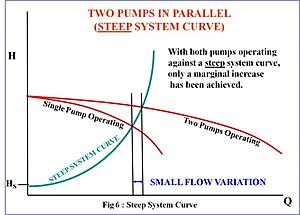
Now this is what happens when you have low restriction system (flat system curve). Pressure isn't the problem, and you get much more flow. This is more effective than series pumps, as the double pressure pump curve would cross the system curve at a lower point than the double-flow curve:
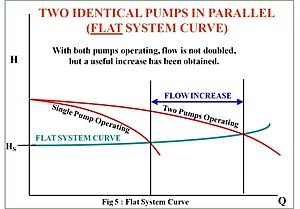
PC gamers take water cooling seriously, and they can be very analytical about it. Here's a good chart that makes it easy to see.
Black line: system curve (resistance)
Thin blue line: pressure vs flow for single pump
Green line: two pumps in parallel (double flow)
Pink line: two pumps in series (double pressure)
The operating point is where the system curve crosses the appropriate pump curve. In the example given, which has a steep system curve (i.e. high resistance) the pink line crosses at the highest flow. That's because it crosses the pump curves below 3gpm, in the region where the series configuration performs better than the parallel. Look at the point where the green and pink curves cross - 3gpm/6psi. This is where they perform the same. If the system curve was shallow (low resistance), and fell to the RIGHT of this point, then the parallel configuration would give more flow.

There's lots of discussion on this subject everywhere you look, but less on what you can do with the other side of the equation - the resistance of the system. Just as pump flow adds in parallel, and pressure adds in series, the same applies to the resistance of the loads in the cooling system. Two heat exchangers in series will have double resistance/low flow, while two HE's in parallel will have half resistance/high flow. Unfortunately half resistance doesn't mean double flow - you have to plot and compare the pump & system curves to get the answer, just as you do with pumps.
It was the discussion on series and parallel pumps that got me thinking about series and parallel heat exchangers. In the case of the V12TT, the two charge coolers are already in parallel, minimising the resistance of the system, even though its obviously still pretty high. The IC's are in series with the HE, so the resistances add, and flow though both is low. My X3 radiator makes a big HE, and its resistance must be very low - it has to flow enough water to cool an engine. But the flow through the HE is obviously being limited by the restriction of the IC's, so I'm not getting as much cooling from the HE as I ought to.
Connecting the IC's and the HE in parallel with the pump means that the IC's aren't in the loop with the pump and HE - so with suitably large pipes, the flow in that loop should go through the roof. Of course this only works with a powerful pump that maintains good pressure at those higher flow rates, and the CWA-200 certainly does that. I'm not sure if that arguement would also apply to the Meziere or Jabsco pumps - other popular but relatively shallow-slope pumps. Might be worth thinking about.
Incidentally, I've been playing with the back seats in my S600 Limo this weekend. I use the word " Limo" advisedly, as the back seat is a bit disappointing for such a large car. The backrest is tall and well-angled, but the cushions are rather short and flat. I removed the cushions and dismantled the electric mechanism. I modified the mountings so the front of the cushion is about an inch higher and further forward. The length and angle are much closer to how I have it in the front, and I think its more comfortable and cosetting. A simple job that's really worth doing. No great effort or downside either.
Nick
Last edited by Welwynnick; 10-13-2013 at 06:24 PM.
#117
MBWorld Fanatic!
Thread Starter
Unbalanced Parallel Chargecooler Plumbing
OK, lets see who's paying attention....
So how can you best use a high-flow pump in a charge cooler system? I had a crazy idea last night, thinking about how to make the most of my BMW coolant pump. This is a Pierburg CWA-200, which generates about 0.5 bar pressure over a wide range of flow rates. Indeed, the optimum operating point is around 120 lpm/32 gpm @ 0.5 bar, which is much more flow than I'm using (see post 108) So I thought about better ways to take advantage of the Pierburg's capability. Even if it was flowing much faster, it would still generate much the same pressure (more even), and that's what's necessary to keep water flowing through the IC's. Regardless of what's happening elsewhere in the system (double pumps, double HE's, whatever) the IC simply needs to "see" the right pressure and flow.
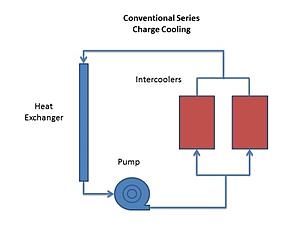
So I thought about running a by-pass pipe directly from the pump outlet to the HE inlet, by-passing the IC altogether. Doesn't make much sense, huh? Surely you want all the water to go through the IC? My thinking was it would increase the flow through the pump and get it working closer to its preferred pressure/flow point. It would increase flow through the HE, but because the CWA-200 has such a flat output curve, it would maintain output pressure at the higher flow rate. Therefore the IC flow wouldn't be affected, but the flow through the HE would be increased, which is a real benefit.
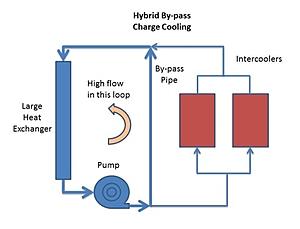
The increased HE flow interested me, but the by-pass to the HE inlet didn't make so much sense, as it would tend to increase the dynamic pressure at the inlet, and reduce the pressure differential across the IC. It was getting late and I wasn't thinking clearly, but I put my head down and things instantly became clearer.
IC systems have high resistance, and its been difficult to cope with that all along. Maybe because of the IC, maybe the HE, maybe the inadequate 3/4" piping. But the thing is they're all in series, with resistance adding up. Why not simply connect them in parallel instead of in series? The two IC's are effectively in parallel with eachother already, so what will putting the HE in parallel do? The ICs will see all the pressure generated by the pump, but the flow through the HE will be higher. My HE is a BMW X3 radiator, which should take the full flow of the CWA-200 - which should be several times higher than the flow through the IC. On average, that means the coolant will pass through the HE several times, for every pass through the IC. It should reduce the temperature of the water going through the IC, due to the repeated HE passes. And as long as the pump is big enough, it should actually increase the flow through the IC, as the pump's output pressure isn't split across both the IC & HE - they both see the full pressure of the pump.
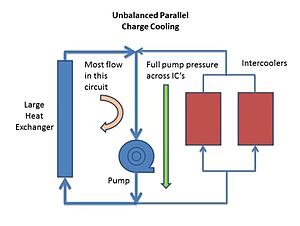
Of course, a proportion of the heated water from the IC will go through the pump and go straight back to the IC without going through the HE. But as long as the HE flow is much higher than the IC flow, most of the water going to the IC's will be extra-cold: colder than it would have been from a single HE pass.
So there's a thought - running the IC and HE in parallel instead of in series. Can that make any sense at all!?!?
The reason it might be a good idea is to make the most of what you've got. The charge coolers are an integrated part of the engine - upgrade them and you have no room for large air filters and cold air inlets, which undermines the benefit of the bigger IC's. The pump and HE are easier to upgrade, and can achieve similar improvements. An IC system is simply a very big heat sink for the charge air, and you want to minimise the thermal resistance between the intake air and the ambient air, so that you maximise heat flow outwards.
An air-to-air system is actually quite good at this, as there's very little between the two air streams - just a thin sheet of finned ally with a reasonable thermal resistance. A water cooled system is rather different, as you have to add to this an interface with the water in the IC, plus an interface with the water in the HE, plus the circulation system. All of that can only add to the thermal resistance of the whole system, so you need to minimise the resistance at both the IC and the HE.
Increasing the flow through the IC helps, but its difficult to make big improvements. Having a large heat exchanger and lots of flow WILL make a big difference to the HE however, and provide lots of cold water for the IC's. So the thermal resistance of the HE cannot be too low - even if the water was circulating at a million mph, it will still be worse than air-to-air, as it can only add to what's already there. Radiators normally run at a temperature delta between inlet and outlet of around 10 degC / 20 degF. So that's one delta for the HE, and one delta for the IC. Ideally, both will be zero, but the idea of a big HE and a big pump is to get that 10 degC delta as close to zero as possible.
Of course the V12TT uses charge cooling for packaging and piping reasons, but there are other advantages. The water passages in the HE are narrower than air passages, allowing MORE rows for a given frontal area. My X3 rad has fifty rows - more than any air-air cooler - and there's less obstruction to ambient air passing through, so other things being equal there will be more through-flow. Similar arguements apply to the IC's as well.
Nick
OK, lets see who's paying attention....
So how can you best use a high-flow pump in a charge cooler system? I had a crazy idea last night, thinking about how to make the most of my BMW coolant pump. This is a Pierburg CWA-200, which generates about 0.5 bar pressure over a wide range of flow rates. Indeed, the optimum operating point is around 120 lpm/32 gpm @ 0.5 bar, which is much more flow than I'm using (see post 108) So I thought about better ways to take advantage of the Pierburg's capability. Even if it was flowing much faster, it would still generate much the same pressure (more even), and that's what's necessary to keep water flowing through the IC's. Regardless of what's happening elsewhere in the system (double pumps, double HE's, whatever) the IC simply needs to "see" the right pressure and flow.

So I thought about running a by-pass pipe directly from the pump outlet to the HE inlet, by-passing the IC altogether. Doesn't make much sense, huh? Surely you want all the water to go through the IC? My thinking was it would increase the flow through the pump and get it working closer to its preferred pressure/flow point. It would increase flow through the HE, but because the CWA-200 has such a flat output curve, it would maintain output pressure at the higher flow rate. Therefore the IC flow wouldn't be affected, but the flow through the HE would be increased, which is a real benefit.

The increased HE flow interested me, but the by-pass to the HE inlet didn't make so much sense, as it would tend to increase the dynamic pressure at the inlet, and reduce the pressure differential across the IC. It was getting late and I wasn't thinking clearly, but I put my head down and things instantly became clearer.
IC systems have high resistance, and its been difficult to cope with that all along. Maybe because of the IC, maybe the HE, maybe the inadequate 3/4" piping. But the thing is they're all in series, with resistance adding up. Why not simply connect them in parallel instead of in series? The two IC's are effectively in parallel with eachother already, so what will putting the HE in parallel do? The ICs will see all the pressure generated by the pump, but the flow through the HE will be higher. My HE is a BMW X3 radiator, which should take the full flow of the CWA-200 - which should be several times higher than the flow through the IC. On average, that means the coolant will pass through the HE several times, for every pass through the IC. It should reduce the temperature of the water going through the IC, due to the repeated HE passes. And as long as the pump is big enough, it should actually increase the flow through the IC, as the pump's output pressure isn't split across both the IC & HE - they both see the full pressure of the pump.

Of course, a proportion of the heated water from the IC will go through the pump and go straight back to the IC without going through the HE. But as long as the HE flow is much higher than the IC flow, most of the water going to the IC's will be extra-cold: colder than it would have been from a single HE pass.
So there's a thought - running the IC and HE in parallel instead of in series. Can that make any sense at all!?!?
The reason it might be a good idea is to make the most of what you've got. The charge coolers are an integrated part of the engine - upgrade them and you have no room for large air filters and cold air inlets, which undermines the benefit of the bigger IC's. The pump and HE are easier to upgrade, and can achieve similar improvements. An IC system is simply a very big heat sink for the charge air, and you want to minimise the thermal resistance between the intake air and the ambient air, so that you maximise heat flow outwards.
An air-to-air system is actually quite good at this, as there's very little between the two air streams - just a thin sheet of finned ally with a reasonable thermal resistance. A water cooled system is rather different, as you have to add to this an interface with the water in the IC, plus an interface with the water in the HE, plus the circulation system. All of that can only add to the thermal resistance of the whole system, so you need to minimise the resistance at both the IC and the HE.
Increasing the flow through the IC helps, but its difficult to make big improvements. Having a large heat exchanger and lots of flow WILL make a big difference to the HE however, and provide lots of cold water for the IC's. So the thermal resistance of the HE cannot be too low - even if the water was circulating at a million mph, it will still be worse than air-to-air, as it can only add to what's already there. Radiators normally run at a temperature delta between inlet and outlet of around 10 degC / 20 degF. So that's one delta for the HE, and one delta for the IC. Ideally, both will be zero, but the idea of a big HE and a big pump is to get that 10 degC delta as close to zero as possible.
Of course the V12TT uses charge cooling for packaging and piping reasons, but there are other advantages. The water passages in the HE are narrower than air passages, allowing MORE rows for a given frontal area. My X3 rad has fifty rows - more than any air-air cooler - and there's less obstruction to ambient air passing through, so other things being equal there will be more through-flow. Similar arguements apply to the IC's as well.
Nick
The following users liked this post:
Khoi Bung Phe (10-06-2019)
#118
MBWorld Fanatic!
Thread Starter
This is the chart that I've been looking forwards to posting for some time. I've combined the curves for the new pumps I've mentioned in recent posts, plus the Lingenfelter test results, and added them to the pumps I compared in post #24 back on page 1.
Pump performance is usually considered using the pump curve and the system curve. These are always plotted on a graph of pressure (vertical axis) against flow (horizontal). The installed operating point is where they cross. I've plotted two charge cooler system curves based on best information I can find (or measure). The lower one is copied from Nunnally's CadyInfo blog, and shows the pressure vs flow curve for the CTS-V charge cooler alone. The upper curve is double the lower one, which reflects various measurements, including mine. The two curves are like best and worst case system resistance, with the upper curve probably being most representative.
Because there are so many pumps, I've ignored the pumps that perform WORSE than the BOSCH, so I've removed the smaller Johnson and Davies Craig pumps (and I was sorely tempted to remove the Meziere, but its a useful point of reference). Still, its a very busy chart, and there were a few more I'd like to have added.
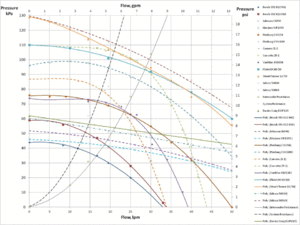
Its easily summarised though. There are three main categories of pumps:
1. Stock IC performance: Around 15 lpm @ 50 kPa:
The dual scales were fun, and I jumped through hoops in vain to make this easy to read. Opening the PDF is the best way.
Enjoy, Nick
Pump performance is usually considered using the pump curve and the system curve. These are always plotted on a graph of pressure (vertical axis) against flow (horizontal). The installed operating point is where they cross. I've plotted two charge cooler system curves based on best information I can find (or measure). The lower one is copied from Nunnally's CadyInfo blog, and shows the pressure vs flow curve for the CTS-V charge cooler alone. The upper curve is double the lower one, which reflects various measurements, including mine. The two curves are like best and worst case system resistance, with the upper curve probably being most representative.
Because there are so many pumps, I've ignored the pumps that perform WORSE than the BOSCH, so I've removed the smaller Johnson and Davies Craig pumps (and I was sorely tempted to remove the Meziere, but its a useful point of reference). Still, its a very busy chart, and there were a few more I'd like to have added.

Its easily summarised though. There are three main categories of pumps:
1. Stock IC performance: Around 15 lpm @ 50 kPa:
- Bosch 392 022 010
- Meziere WP136S
- Johnson CM90
- Jabsco 50840
- Davies Craig EWP115
- Pierburg CWA-200 and several other coolant pumps like the the Dayton 5PXX0 also fall into this category
- Bosch 392 022 002 is a step behind the others
- Peirburg CWA-50
- VariMax 410110
- Camero ZL-1
- Pierburg CWA-100
- Flojet DC40/10
- Corvette ZR-1
- Stuart Turner 12/50
- Jabsco 50860
- Stewart-EMP E2512A would also be in this category, as Lingenfelter measured the installed flow the same as the ZR-1
- Pierburg CWA-400 scrapes into this category, but its a coolant pump, and would be stalled as an IC pump
The dual scales were fun, and I jumped through hoops in vain to make this easy to read. Opening the PDF is the best way.
Enjoy, Nick
Last edited by Welwynnick; 10-18-2013 at 07:58 AM.
#119
I went a whole different direction. I wired up 2 Johnson CM30 pumps in opposite ends and the flow increased dramatically. Run after run wide open and the temps are always back down instantly. I also have the Speedriven intercoolers and bigger heat exchanger so I needed more coolant flow through them. Coolant capacity has almost doubled so I figured two pumps are better than one. Since the Johnson CM30's are magnetic pumps, they draw little voltage compared to the stock Bosch. So all I did was wire them together on the same circuit. This is what I did and its working out great. Did anyone else use this layout?
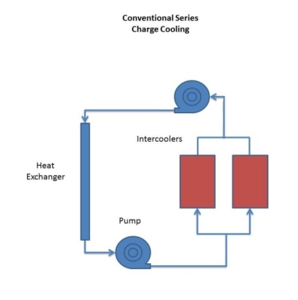

#121
MBWorld Fanatic!
Thread Starter
Curiosity has gotten the better of me, and I've just bought a new S65 heat exchanger and an "SLS Pump" - also known as the new Renntech pump - see this thread.
Here are some pictures and measurements comparing the (new) S65 HE with my (very old) S600 HE.
The S600 HE matrix has 27 rows and measures 580 x 265 x 21 mm
The S65 HE matrix has 45 rows and measures 580 x 400 x 23 mm
Almost all radiators and heat exchangers have 10mm row spacing, so I originally thought the S65 HE was 450mm high, but it appears the rows are about 9mm apart, so its only 50% deeper than the S600 HE. It is a little bit thicker though, and the header tanks are a much better design.
The S65 HE obviously has the steering cooler built in, but its done in a strange way. You'd think that the smaller cooler would be attached to the bigger one, but if anything its the other way round.
Nick
Here are some pictures and measurements comparing the (new) S65 HE with my (very old) S600 HE.
The S600 HE matrix has 27 rows and measures 580 x 265 x 21 mm
The S65 HE matrix has 45 rows and measures 580 x 400 x 23 mm
Almost all radiators and heat exchangers have 10mm row spacing, so I originally thought the S65 HE was 450mm high, but it appears the rows are about 9mm apart, so its only 50% deeper than the S600 HE. It is a little bit thicker though, and the header tanks are a much better design.
The S65 HE obviously has the steering cooler built in, but its done in a strange way. You'd think that the smaller cooler would be attached to the bigger one, but if anything its the other way round.
Nick
#122
MBWorld Fanatic!
Thread Starter
3. Best IC performance: Around 25 lpm @ 100 kPa:
- Pierburg CWA-100
- Flojet DC40/10
- Corvette ZR-1
- Stuart Turner 12/50
- Jabsco 50860
- Stewart-EMP E2512A would also be in this category, as Lingenfelter measured the installed flow the same as the ZR-1
- Pierburg CWA-400 scrapes into this category, but its a coolant pump, and would be stalled as an IC pump
The Stewart E2512A is also sold as the EMP or Europump WP29, and there's lots of information about it:
http://www.europump.ca/uploads/WP29.pdf
http://www.emp-corp.com/media/MarketingMaterial/WP29/SpecificationSheets/ElectricWaterPump.pdf
http://www.emp-corp.com/products/advanced/WP29-electric-water-pump/
Its a big pump - at full speed it pumps over 15gpm @ 20psi. Its quite expensive (though not unreasonable) needs one inch pipes, and it uses a lot of power, but it has more flow AND more pressure than anything else. The motor is water cooled, like the Pierburg pumps, and it has electronic control and an electronic communtator (no brushes), so it has a big MTBF. If you want the best IC pump, this is it.
Nick
Last edited by Welwynnick; 11-04-2013 at 03:27 PM.
#123
MBWorld Fanatic!
Thread Starter
I thought everyone following this thread would enjoy this test that Lingenfelter did on intercooler pump flow tests. They have a bosch pump from a cobra in the test.
http://ls1tech.com/forums/forced-induction/1638572-intercooler-pump-flow-testing-results.html
http://ls1tech.com/forums/forced-induction/1638572-intercooler-pump-flow-testing-results.html
I'm not sure I want to consider the over-rated EMP pump, which looks like a monster, but the VariMax pump looks like a great candidate.
The Stewart E2512A is also sold as the EMP or Europump WP29, and there's lots of information about it:
http://www.europump.ca/uploads/WP29.pdf
http://www.emp-corp.com/media/MarketingMaterial/WP29/SpecificationSheets/ElectricWaterPump.pdf
http://www.emp-corp.com/products/advanced/WP29-electric-water-pump/
Its a big pump - at full speed it pumps over 15gpm @ 20psi. Its quite expensive (though not unreasonable) needs one inch pipes, and it uses a lot of power, but it has more flow AND more pressure than anything else.
http://www.europump.ca/uploads/WP29.pdf
http://www.emp-corp.com/media/MarketingMaterial/WP29/SpecificationSheets/ElectricWaterPump.pdf
http://www.emp-corp.com/products/advanced/WP29-electric-water-pump/
Its a big pump - at full speed it pumps over 15gpm @ 20psi. Its quite expensive (though not unreasonable) needs one inch pipes, and it uses a lot of power, but it has more flow AND more pressure than anything else.
Initially I shied away from any sort of overdriven product that might work great for drag racers, but not for a daily driver. However, I think Lingenfelter have been a bit misleading about their modification or upgrade. Looking at the EMP websites and documents for the pump, it seems that the upgrade performance is simply the EMP Stewart pump running at full speed. Lingenfelter are simply proving EMP's own performance claims.
So I added all the data I could find to my pump comparison chart, so everyone can see just how good the EMP WP29 is (and how bad the CM30 is - which is still promoted as an upgrade by a lot of tuners). A word of caution though, the EMP only achieves those results when used with 1" hoses.
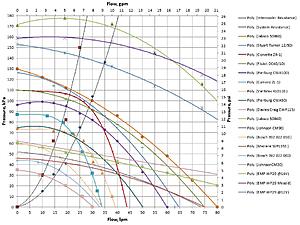
Its a busy chart, but the PDF version is much better as usual. Note that I've expanded both axes to fit the EMP results, and I've added the Johnson CM30 back in, so everyone remembers how weak it is.
The legend lists the pumps in the order they appear on the chart, apart from the EMP curves, which are at the bottom because I plotted it against the secondary (imperial) axes.
Notice the big difference between the 12V and 14V curves - it affects comparisons between closely-matched pumps. As does anti-freeze percentage and coolant temp, to a leser extent.
Nick
Last edited by Welwynnick; 11-09-2013 at 08:51 AM.
#125
Super Member
Join Date: Nov 2012
Location: Germany
Posts: 698
Received 16 Likes
on
13 Posts
C215 CL55 AMG, W124 500E, W210 E430, W124 300E
Thanks veeeery much for all your work.
Really its time to see some real world results :-) Recovery time, max IAT, etc.
Thanks alot, i look forward to your reviews and ongoing commitment :-)
Really its time to see some real world results :-) Recovery time, max IAT, etc.
Thanks alot, i look forward to your reviews and ongoing commitment :-)




